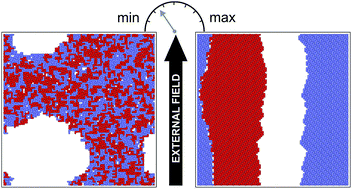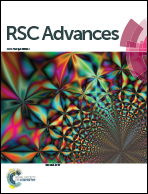Theoretical investigations of the 2D chiral segregation induced by external directional fields†
Abstract
Achieving control over structure of adsorbed chiral overlayers is an important objective in the fabrication of functional surfaces with predefined optical, adsorptive and catalytic properties. In this contribution we explore the surface-confined segregation of enantiomers of model prochiral molecules that is triggered by continuous breaking of their orientational symmetry and which leads to the creation of extended homochiral domains. To that end we use the lattice gas Monte Carlo method combined with a coarse-grained representation of prototype prochiral molecules comprising a few identical segments arranged in different shapes. The adsorbed enantiomers are assumed to interact via short-ranged attractive segment–segment interaction potential limited to nearest neighbors on a square lattice. Additionally, to account for the external asymmetric input which breaks the orientational symmetry (e.g. electric or magnetic field) we assume that the prochiral molecules are able to couple with continuously changed directional field parallel to the surface. It is demonstrated that by fine tuning of the external field, which orients the molecules in one direction, it is possible to induce a complete segregation of the adsorbed enantiomers. The effect of size and shape of the molecules on the extent of the corresponding 2D separations is also assessed. The theoretical findings of our study can be helpful in developing strategies for 2D chiral separations in which external stimuli are used and they can give hints for design and fabrication of new responsive materials.


 Please wait while we load your content...
Please wait while we load your content...